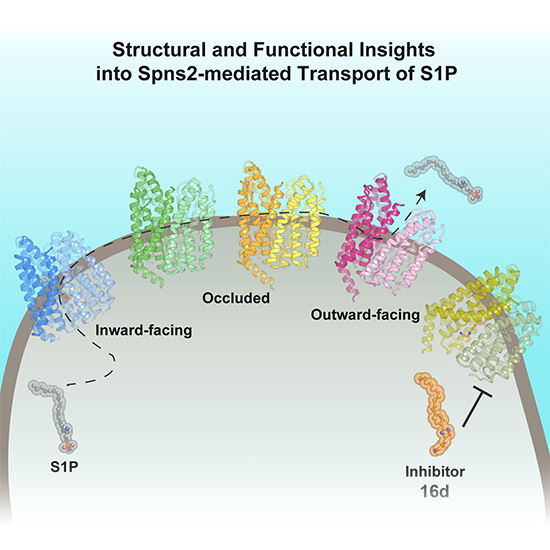Possible treatments ‘in sight’
Cryo-EM images focus on transporter protein in cancer, multiple sclerosis

UT Southwestern researchers using advanced microscopes have shown how a lipid that regulates development of the heart, nerves, and immune system is exported out of cells so it can do its job. Knowing the structure of this fat molecule bound to its transporter protein holds promise for someday improving treatments for lung cancer, multiple sclerosis (MS), and other diseases.
The secreted lipid sphingosine 1-phosphate (S1P) and its transporter protein Spinster homolog 2 (Spns2) are also implicated in a form of hearing loss and in ulcerative colitis, said Xiaochun Li, Ph.D., an Associate Professor of Molecular Genetics and Biophysics and a member of the Harold C. Simmons Comprehensive Cancer Center. Dr. Li is the corresponding author of the study in Cell, and the lead author is Hongwen Chen, Ph.D., a postdoctoral researcher in the Li lab.

“In mouse models, having low levels of Spns2 seems to protect against the development of MS, an autoimmune condition that attacks the nerves, particularly the brain and spinal cord,” Dr. Li said. “In addition, the loss of that protein (Spns2) seems to reduce the chances of lung cancer spreading, or metastasizing. We believe our findings in mouse models will likely hold for people. We hope that patients with these diseases might benefit from the development of drugs that inhibit Spns2.”
The group studied one experimental agent, called 16d, which inhibits Spns2. Using cryo-electron microscopy (cryo-EM), they found that binding 16d to the transporter protein appears to lock it into a state that renders it nonfunctional.
“Currently, drugs that modify S1P signaling are used to treat MS, but they have some serious side effects. Hence, the search for more targeted therapies seems imperative. This first Spns2 inhibitor was identified by a group at Virginia Tech last year and is still investigational without any clinical trials as yet. We consider it a possible drug candidate for MS and cancer,” Dr. Li said.

The teams collected their data at cryo-EM facilities at UT Southwestern and at St. Jude Children’s Research Hospital in Memphis, Tennessee. Cryo-EM technology freezes proteins in place to generate atomic-resolution images. The method is particularly effective for molecules located in or crossing cell membranes, a mixture of proteins and fats such as the lipid and its transporter in this investigation.
“We gathered cryo-EM images of Spns2 in five distinctive states,” Dr. Li said. “These atomic-resolution pictures illuminate the transport cycle of Spns2 for the first time and also provide a blueprint for the development of next-generation Spns2 inhibitors.”
UTSW co-authors include Jae Hun Kim, M.S., an analytical chemist in the Center for Human Nutrition, and Jeffrey McDonald, Ph.D., Professor of Molecular Genetics and a member of the Center for Human Nutrition. Scientists from St. Jude and the Technical University of Berlin also participated.
This work received support from the Damon Runyon Cancer Research Foundation (DRR-53S-19), the National Institutes of Health (P01HL160487, 1P30DK127984, RO1GM135343, RO1GM143282), The Welch Foundation (I-1957), and ALSAC.

